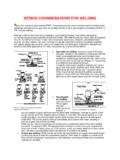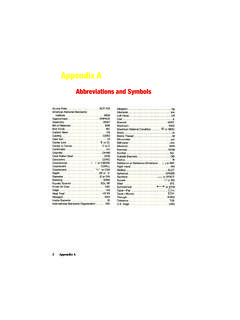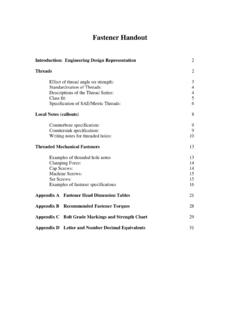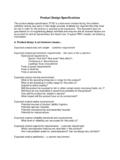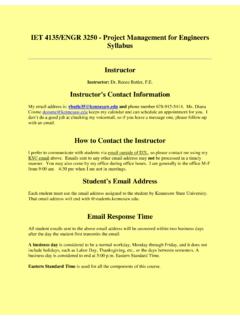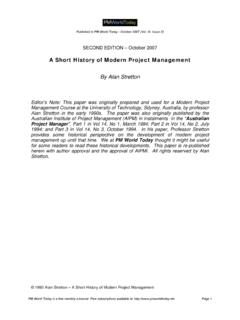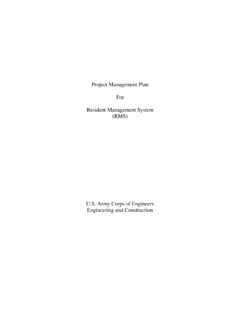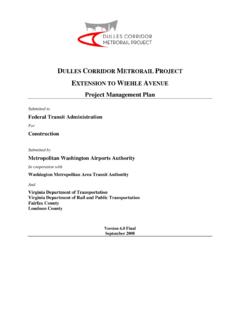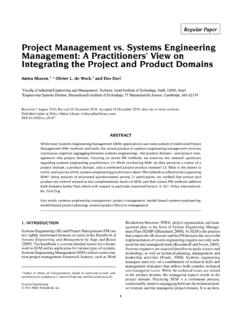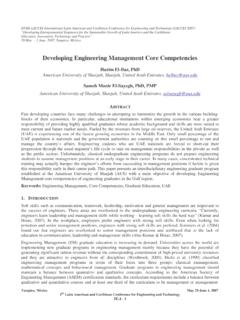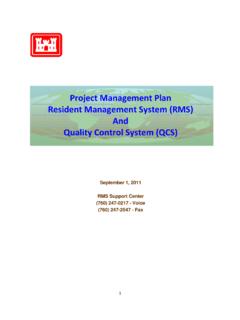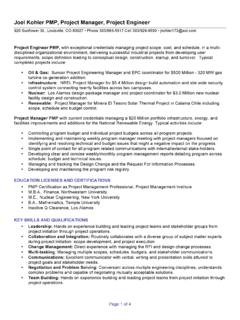Transcription of ME349 Engineering Design Projects - CAE Users
1 ME349 Engineering Design Projects project Planning Engineers and Engineering teams vary greatly in how they carry out their Projects , in the university and in business. Their performance varies from smooth easy productivity, to complete chaos ending in failure. Variations are expected, because of the inherent differences in the difficulties in the Projects . This alone is not sufficient to explain all the differences in performance. On close examination, the variation can usually be attributed to the lack of proper planning and control. High performing engineers and Engineering teams always have their project under control. When faced with an impossible task they must act quickly, face it, and reorient themselves. They overcome the difficulty and then get on with the next problem. A project is a set of activities which ends with specific accomplishment and which has (1) Routine and non-routine tasks, (2) Distinct start/finish dates, and (3) Resource constraints (time/money/people/equipment).
2 Tasks are activities that must be completed in order to achieve the project goal. Tasks have start and end points, are short relative to the project and are significant. Use verb-noun form for naming tasks (not "going to library", but rather, "search literature"), other examples would include "create drawings" or "build prototype". Use action verbs such as "create", "define" and "gather" rather than "will be made". Each task has a duration or time to completion. You may find it difficult to accurately estimate the duration of tasks. Doubling your best guess usually works well. The basic elements of any project are the same. The differences can be attributed to the difficulties and details of completing the basic elements. A typical project would consist of the following elements: Defining the objectives of the project Defining the constraints; physical, financial, manpower, and time Gathering information Generating alternate methods of solution Evaluating alternative solutions Selecting the best solution Carrying out solution Evaluating against objectives Generalizing and extending the results Iterate Report results.
3 Simply recognizing that these things have to be done is not project planning. Planning means identifying the specific tasks that must be accomplished for each element of the project . In other words, the questions of what must be done, by whom, and when. Good project planning means identifying, early and continuously, the specific tasks that must be achieved. It also means considering the resources in money, personnel, facilities, and time available. In cases where more than one person is required, specific tasks are assigned to the individuals by name. They must commit themselves to accomplishing the task within a fixed time. And, there should be little or no duplication of effort between individuals. The interfaces between tasks must be recognized and the responsibility for resolving the differences assigned.
4 Beyond the responsibility for performing his or her own specific tasks; every engineer on the team must accept the responsibility for the success of the whole project . An excellent Engineering task that is part of an unsuccessful project is wasted. From experience it is apparent that: Good technical work is often obscured and even negated by poor administrative control. Good technical work cannot by itself control a project , and a project cannot control itself. Engineers must consciously work at controlling their Projects . As the work on a project progresses the plans and schedules must change. Many engineers erroneously believe that technical work cannot be controlled. This in itself becomes a self-fulfilling prophesy. Management expects and demands that technical work be administered and controlled effectively.
5 project control is making sure that the technical objectives of a project are achieved within the time and money constraints. Time and money scheduling is not separated from the technical activity. Technical decisions by their very nature affect time and money considerations. Most Projects do not permit the use of infinite time or money. Usually restrictions on time and/or money are established at the start. This represents a constraint of the project . The question is no longer, how the technical requirements are optimized. Rather, the question becomes, how to accomplish the technical requirements with the time and money available. Therefore the technical goals schedules are based upon the time and money available. With the cost and delivery fixed as cornerstones, the technical effort must be made to fit.
6 Engineers must take responsibility for the control of their Projects . If they do not, management will assign others to the control. Then the engineer will not have all of the factors under his or her jurisdiction. If others have control of time and money, rational trade-offs cannot be made. Control comprises of those administrative measures that need to betaken to get and keep a project on schedule with respect to time and money. Scheduling To schedule successfully, the engineer must identify and list the tasks that must be accomplished, and identify and list the activities required. The level of detail will depend on the purpose of the schedule and who will use it. If too little detail is included, not enough planning takes place to anticipate major problems. If too much detail is included, the important tasks and milestones become obscure which then reduces flexibility.
7 The level of detail should reflect the size and importance of the project . The preparation of a schedule generates a checklist used to ensure that nothing is forgotten during the planning stage. Milestones are important checkpoints or interim goals for a project . They can be used to catch scheduling problems early. When generating timelines or Gantt charts (see below), name milestones by the same noun-verb form as tasks, "report due", "parts ordered", and prototype complete". On large Projects it is sometimes convenient to produce a relatively non-detailed schedule covering the entire project . This is supplemented periodically with more detailed schedules showing decisions and assignments over short intervals between events in the overall schedule. These supplementary schedules can be produced as the project moves into different phases of the work.
8 It is essential to make and maintain schedules. When the project involves a team, the schedule must be produced and distributed in a form that is easy to understand. Those using it and responsible for the work should easily see where they stand and understand what is expected of them. Each individual should perceive exactly what he or she is responsible for, and how their effort fits into the overall schedule. Although actual names do not normally appear on the schedule, the items on the schedule should appear in such a form as to permit each item to be identified with a single individual. Often tasks overlap in time on a schedule. This may show the interdependency between tasks or resources. It is therefore valuable to find, list, and show the milestones that indicate the start or completion of tasks.
9 Milestones should indicate when resources or information from one task must be available for use in another task. Thus the schedule will indicate when a task is completed and what resources are available to perform or start additional tasks. Sometimes, there may be a cost schedule associated with the time schedule. This cost schedule shows the relative intensity of activity on the project . The cost schedule acts as warning if the costs are out of control. It ensures there is a reasonable balance between costs and time, and that time/cost trade-offs are made deliberately. Schedules provide a common meeting place between engineers, co-workers, and management during its construction and its subsequent updating. If everyone contributes to its construction and agreeing to its validity, everyone will make ever effort to keep to it.
10 Where necessary; when circumstances dictate; changes can made without recriminations. Gantt Chart The simplest scheduling tool is the Gantt, or bar, chart. The activities are listed in the vertical direction, and elapsed time is recorded horizontally. This shows clearly the date by which each activity should start and finish, but it does not make clear how the ability to start one activity depends upon the successful completion of other activities. Monitoring No matter how good the schedules are; if they are not used for monitoring they serve very little purpose other than recording expectations. Monitoring does not require holding to the schedule rigidly. Circumstances change and as the project develops new information becomes available that may require a change in plans. The schedules serve as a yardstick against which to measure progress, to show where and how plans must change.
